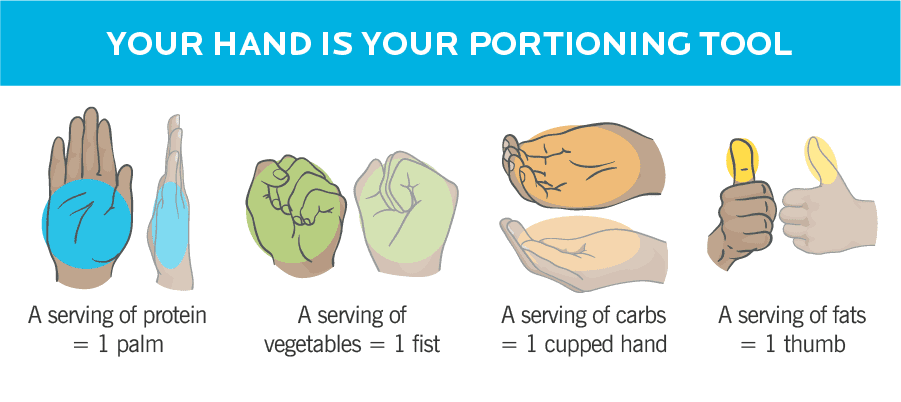Reviewed by Brian St. Pierre, MS, RD
Carbohydrates, proteins, and fats are the foundation of any diet.
These nutrients fall into a nutritional category called macronutrients, or “macros.”
And if you’re in the health and fitness industry, you’ve no doubt heard of—or maybe even tried—precise macronutrient “formulas” or “splits” to achieve specific goals.
But do you have to manipulate your macros—say, sustain a specific amount and ratio of carbs, proteins, and fat—to make athletic or aesthetic progress? What if you’re just trying to be healthy, in a general way?
In other words:
Should YOU be tracking your macros?
Below, we’ll take a look at the pros and cons of this practice to help you decide whether or not you should track your macros.
What are macros in fitness?
Macronutrients are the primary nutrients that fuel your body and support various physiological functions. They’re broadly categorized into carbohydrates, proteins, and fats, each with its distinct role in maintaining health and fitness.
- Carbohydrates are our body’s primary energy source, providing 4 Calories per gram. They play a crucial role in energy production and supporting muscle growth.
- Protein also provides 4 Calories per gram, and is vital for building and repairing muscles post-exercise.
- Fat, which supplies 9 Calories per gram, is not just an energy source. It’s essential for hormone production and appetite regulation.
Alcohol also has an impact on the macronutrient profile of your diet. At PN, we refer to alcohol as the “fourth macronutrient.” It contains 7 Calories per gram, the majority of which are derived from the fermentation of starch and sugar.
When you understand the purpose of these three (and sometimes four) macronutrients, you can better craft a nutrition plan that meets your personal goals—regardless of what they are.
When to track your macros
You might wonder:
“Do macros matter when bulking?”
Or:
“Does tracking macros help you lose weight?”
The answer is that if you have specific fitness or body composition goals—such as building muscle or losing weight—macronutrients matter, but tracking them isn’t absolutely necessary to achieve them.
It is, however, a tool that can help you achieve your goals with steadier progress.
For instance, a recent study from the University of Connecticut, University of Florida, and University of Pennsylvania found that, on average, the more consistently people tracked their food, the more weight they lost.1 Being aware of your caloric and macronutrient intake can provide insights that can help you make the necessary dietary adjustments.
But that doesn’t mean tracking guarantees the best results.
In the above study, the person who lost the most weight hardly tracked their food intake at all. So, individual results definitely vary.
When NOT to track your macros
While macro tracking has its advantages, it’s not suitable for everyone. A notable concern is its potential link to disordered eating habits.2 Those with a history of disordered eating might find macro tracking triggering or stressful, as it’s rooted in the counting and budgeting of energy sources.
People can achieve excellent health without rigorous tracking, so if a person has a history of disordered eating behaviors or an unhealthy obsession with food tracking, methods like intuitive eating might be a better fit. (Read more: Macros vs. calories vs. portions vs. intuitive eating: What’s the best way to ‘watch what you eat?’)
Other benefits of tracking macros
Beyond the primary benefits linked to achieving fitness and/or body composition goals, tracking macros offers several other advantages that benefit overall well-being:
Benefit #1: Increased awareness of the types of food you’re eating
Tracking macros not only brings attention to calorie intake, but also to the quality and type of those calories. When you become more aware of what you’re eating, you can:
- Build a more diversified diet: With tracking, you might notice a recurring pattern or lack of certain food groups in your diet. This can encourage you to include a greater variety of nutrients and minimize potential nutrient deficiencies.
- Develop your own nutrition knowledge: The process of tracking helps you learn about different foods’ nutritional profiles. Over time, this knowledge allows you to make informed choices even when you’re not actively tracking.
- Eat more mindfully: While it might sound counterintuitive, understanding the macros in different foods can help with mindful and/or intuitive eating. Instead of just thinking of macros as numbers you need to hit, they can also help you better start connecting what you eat with how you feel.
Benefit #2: Tracking helps ensure you’re eating enough
Tracking macros isn’t just for weight loss. Athletes, bodybuilders, or those who practice high-intensity workouts have significant calorie and nutrient demands.
Tracking can help you make sure you’re meeting those energy demands, and will also:
- Support your workouts: Ensuring you’re meeting your macro targets can help you optimize performance and muscle gain. For those wondering, “Do you have to track macros to gain muscle?”—it can provide an edge.
- Promote muscle recovery: Adequate protein intake, tracked and ensured through macro counting, is essential for muscle repair and growth.
- Inhibit metabolic slowdown: Dieting for long durations doesn’t “damage” your metabolism, but the body does adapt to weight loss—expending less energy by slowing down your metabolism. Tracking your macros can ensure you’re getting enough protein, and not creating too large of a caloric deficit, both which can limit metabolic slowdown.
Benefit #3: Tracking provides insights into how different foods affect your body
It’s not just about calories; It’s about how those calories make you feel. Tracking macros can reveal more than just numbers:
- Food intolerances and sensitivities: While macro tracking isn’t necessarily about tracking specific foods, being aware of the amounts and types of food you eat might help you notice patterns. Over time, if you notice bloating, fatigue, or any adverse reactions after consuming certain foods, it might indicate an intolerance or sensitivity.
- Energy levels: By tracking your macros along with tracking changes in your mood, energy levels, or athletic performance, you can start to see the effects of various macronutrient ratios or splits. For instance, some might find that eating more carbs improves their energy levels and workout performance. On the other hand, some might find that eating more protein helps balance their mood and appetite.
- Mood and Mental Well-Being: The correlation between diet and mental health is becoming more clear.3 Tracking might help identify patterns between consuming certain foods and mood fluctuations. For example, excessive sugar intake might be linked to mood swings for some individuals.
Armed with these insights, it can be easier for you to make informed decisions, letting you tailor your diet not just for physical results, but for mental and emotional well-being as well.
Other drawbacks of tracking macros
While tracking macros provides many with the clarity and direction they seek for their dietary habits, it’s not without its shortcomings.
Drawback #1: Tracking can be time-consuming and tedious
The commitment to diligently logging every morsel is no small feat. You’ll have to be prepared for:
- Constant vigilance: For those who try to achieve the most precise tracking, everything—from the splash of milk in your coffee to the extra drizzle of dressing on your salad—has to be accounted for. This requires consistent attention to detail.
- Challenges of eating out: With conventional macro tracking, dining out becomes a game of estimations. While some restaurants offer nutritional information, many don’t, making it tricky for those keen on accurate tracking. Certain macro tracking methods, however, like our Hand Portion method, can help you track consistently—and a little more easily—when eating at restaurants.
- Impact on social life: The need to constantly measure and log can interfere with social engagements, turning simple pleasures like shared meals into complex (and awkward) calculations.
Drawback #2: It’s impossible to calculate the exact amounts
Not everything we consume comes with a neat nutrition label. Even when foods do come with a nutrition label, there can be inaccuracies in the reported nutritional information. Other aspects that make accurate tracking difficult include:
- Homemade meals: If you’re eating a dish prepared by someone else or a recipe that doesn’t have a detailed nutritional breakdown, it’s a challenge. This requires you to dissect ingredients and quantities, which isn’t always feasible.
- Varied nutritional profiles: Even foods that seem consistent, like fruits and vegetables, can have varied macro profiles depending on factors like ripeness, storage, and preparation method.
- Potential for errors: Reliance on macro-tracking apps and databases might lead to inaccuracies. Research shows that these sources of information can often be off by quite a large percentage, plus different sources may provide varied data for the same food item, leading to confusion.
Drawback #3: Tracking doesn’t account for food quality
Achieving macro targets doesn’t automatically mean you’re eating a nutritious diet.
You’ll also want to keep in mind:
- Necessary micronutrients: Focusing solely on macros might lead to neglecting essential micronutrients. Vitamins, minerals, phytonutrients and other compounds play crucial roles in overall health.
- Holistic health: Consuming processed foods that fit your macro profile might meet numerical goals, but your body also needs fiber, antioxidants, and other beneficial compounds predominantly found in whole foods.
- Digestive health: Two foods might have similar macro profiles but very different fiber content. White bread and whole grain bread, for example, have very similar macro profiles, but their fiber and phytonutrient contents vary greatly. Overlooking this aspect can impact digestion and overall gut health.
While macro tracking offers a structured approach to achieving certain nutrients, it’s essential to approach it with a broader perspective on health and nutrition. Being aware of these drawbacks can lead to more balanced (and healthier) choices.
How exactly do I track my macros?
Tracking macros can feel like a daunting task, especially with the plethora of information available. The key is to find a method that’s both accurate and sustainable for you.
The basics of macro tracking
Before diving into the tools and methods, there are some general things you should know about tracking and logging:
- Understand food labels: Being able to read and interpret nutrition labels is a fundamental skill. Learn what each section means, including serving size, total calories, and macronutrient breakdown.
- Consider investing in a digital food scale: A reliable digital kitchen scale can productively support your macro tracking. It gives precise measurements, ensuring that you’re logging the exact portion you’re consuming.
- Remember that consistency is key: Whether you’re estimating or weighing your food, being consistent in your method will provide the most reliable results over time.
Traditional weighing and measuring
When cooking and preparing meals for yourself, the best way to calculate macros is by weighing and measuring them. Here are some tips on how to do so successfully:
- Use a food scale: Weigh your ingredients before cooking or mixing together. For instance, if you’re making a chicken salad, weigh the raw chicken, vegetables, and any other components separately.
- Consider measuring cups and spoons: While not as precise as scales, they’re useful for liquids or ingredients that are challenging to weigh.
- Account for cooking: The weight of certain foods can change significantly when cooked. For example, 100 grams of raw chicken won’t weigh the same once grilled. Make sure that you know how your food might change, and stay consistent with how you measure and track it.
Precision Nutrition’s Hand Portion method
For those who find weighing every ingredient cumbersome (probably the majority of us!), the Hand Portion method offers a quicker and easier approach:
- Protein portions: The size of your palm is a good estimation for a single serving of protein from sources like chicken, beef, or tofu.
- Vegetable portions: A fist-sized portion is typically recommended for veggies.
- Carbohydrate portions: For carb-rich foods like grains, rice, fruit, or potatoes, a cupped hand represents a portion.
- Fat portions: For fats, the thumb’s size is a general guideline, applicable to oils, butters, nuts, and seeds.
 This method is convenient, easy to understand, and excellent for those who prefer flexibility and fewer calculations.
This method is convenient, easy to understand, and excellent for those who prefer flexibility and fewer calculations.
And because each hand portion correlates to an approximate amount of each macronutrient, calorie and macro counting is more or less built into this system.
Our internal research shows that using hand portions to track your macros is 95% as accurate as carefully weighing, measuring, and tracking your food, but with substantially less time, and the convenience of having your hand—your measuring tool—with you everywhere you go.
Digital macro tracking tools
Tools like Cronometer, fatsecret, and My Macros+ can also be helpful aids in macro tracking.
They best serve those who want to get the most accurate numbers for their macros and are willing to put up with the tradeoffs of such meticulous tracking. These tools usually have food databases, barcode scanners, and other features to log and save custom recipes.
But in some cases, tools like this contribute to the risk of disordered eating habits (or fueling the thought patterns that can lead to disordered eating).
What else you need to know about tracking macros
Tracking your macros isn’t just about food math or adhering to specific ratios: It’s a personalized approach to understanding your body’s unique nutritional needs.
Here are some general reminders as you set out on your macro-tracking journey:
- Every individual is unique: The standard macro ratios you often see (like 40% carbs, 30% protein, and 30% fat) are general guidelines. Depending on a wide variety of factors, your ideal ratio might look different.
- It’s more than three numbers: Apart from carbs, protein, and fats, consider tracking fiber, micronutrients (like vitamins and minerals), alcohol, and water intake. This ensures a well-rounded approach to nutrition.
- Macros and exercise: Depending on how active you are, your macro needs will vary. For example, if you’re doing intense workouts a few days a week, your body might benefit from a higher intake of carbs. After a strength training session, additional protein can aid in muscle recovery.
- Stress and sleep impact nutrition: Your stress levels and sleep patterns can influence how your body processes and uses nutrients.4 Someone under chronic stress or with disrupted sleep might need to adjust their macro distribution.
- Avoiding obsession: While tracking can be beneficial, it can also lead to an unhealthy obsession with numbers. Remember, it’s a tool for understanding and not a strict rule.
- Biofeedback is key: Always consider signs from your body. If you’re constantly tired, hungry, or moody, it might be time to reassess and adjust your macro ratios, even if they don’t align with “recommended” values.
- Adjust and re-evaluate: Our bodies change, and our nutritional needs do, too. Periodically reassess your macro ratios in the context of your current health goals, activity levels, and how you feel day-to-day.
- Consult a professional: If you’re ever in doubt or feel overwhelmed, consult a professional coach. They can offer personalized guidance, ensuring you’re nourishing your body optimally.
Find your ideal macronutrient ratio
Every individual’s macro needs differ. Lots of factors—like age, gender, activity level, and more—play a role.
Precision Nutrition’s Macronutrient Calculator can offer an ideal starting ratio.
If tracking macros aligns with your goals, this tool can help you begin with personalized advice.
Remember, it’s always about balance and what feels right for your body.
References
Click here to view the information sources referenced in this article.




Share